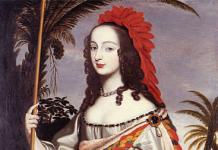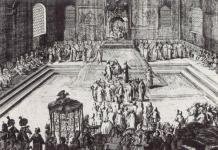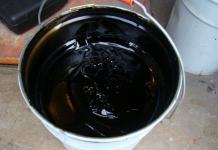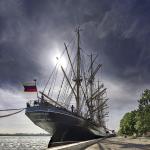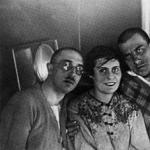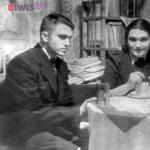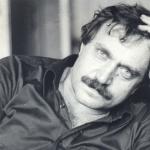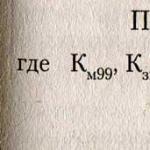On October 20, 1696 (which corresponds to October 30 according to the Gregorian calendar), the Boyar Duma, on the proposal of Tsar Peter I, adopted the resolution “Sea vessels shall be...”, and this became the first law on the fleet and recognition as the official date of its founding.
And at the beginning of March 1697, people left Russia for Western Europe Grand Embassy. The following were appointed as Grand Plenipotentiary Ambassadors:
Lefort Franz Yakovlevich - Admiral General, Novgorod Governor;
Golovin Fedor Alekseevich - general and military commissar, Siberian governor;
Voznitsyn Prokofy Bogdanovich - Duma clerk, Belevsky governor.
With them there were more than 20 nobles and up to 35 volunteers, among whom was a sergeant of the Preobrazhensky Regiment Pyotr Mikhailov- the king himself Peter I, who actually led this large-scale expedition to the West to study European experience and, above all, naval art. Peter, who had just conquered Azov, was faced with the task of creating a powerful navy. On the special wax seal that the king put on his letters during the trip, there was the inscription: “I am a student and am looking for teachers.”
Formally, Peter followed incognito, but his conspicuous appearance easily gave him away. And the tsar himself, during his travels, often preferred to personally lead negotiations with foreign rulers. Perhaps this behavior is explained by the desire to simplify the conventions associated with diplomatic etiquette.
The Great Embassy of Peter I to Europe (1697-98). On the right is a portrait of Peter in sailor's clothing during his stay in the Dutch Saardam (Saandam). Engravings by Marcus. (1699)
The embassy visited Courland, East Prussia, Holland, and Austria. Peter I traveled to England with part of the embassy for three months. The proposed trip to Venice was canceled due to news of the Streltsy riot in Moscow and the hasty return of Peter I to Russia in August 1698.
A special place in this journey was occupied by one of the largest maritime powers in Europe - Holland.

Russian ambassadors in The Hague
Holland, the most advanced country of this time, the world's first bourgeois republic, the main maritime power. In this capacity, it has already surpassed Spain and has not yet yielded to England. Of the five ships on the world's oceans, four are Dutch. In Russian, most maritime words are Dutch borrowings, from “accident” and “iceberg” and further, up to “skipper”, “hose” and “steering wheel”.
Holland had long attracted the Tsar, and in no other European country of those times did they know Russia as well as in Holland. Dutch merchants were regular guests of the only Russian seaport of that time - the city of Arkhangelsk. Even under Tsar Alexei Mikhailovich, Peter’s father, there were a large number of Dutch artisans in Moscow; Peter's first teachers in maritime affairs, led by Timmerman and Kort, were Dutch; many Dutch ship carpenters worked in Voronezh shipyards during the construction of ships for the capture of Azov. Mayor of Amsterdam Nikolai Vitzen I was in Russia under Tsar Alexei Mikhailovich and even traveled to the Caspian Sea. During his travels, Witzen developed strong relationships with the Moscow court; he carried out orders from the tsarist government to order ships in Holland, hired shipbuilders and all sorts of craftsmen for Russia.

Conversation of Peter I in Holland. Unknown Dutch artist. 1690s GE
Peter arrived in Holland with his inner circle on August 8, 1697. He got ahead of the embassy convoy and, without stopping in Amsterdam, went to the small town of Saardam, (modern Zaandam), which was famous for its shipyards. He arrived in Zaandam on Sunday, August 18, 1697 (old style).

Postcard from 1901
Approximately where a monument to him would later be erected, the tsar met a blacksmith he knew from the Voronezh shipyard, Gerrit Kist, and went to stay with him. They put Peter in a closet under the hayloft; Peter slept in the closet, as was customary in Holland back then. It was believed that if you sleep half-sitting, blood would not flow to the head, which was very good for health. Napoleon was here, he said: “For a great man, nothing is small.”

On August 19, Peter began working at the Linst Rogge shipyard as a simple carpenter. In his free time, he inspected factories, mills and workshops in the Zaan region. I visited local residents, especially families whose members worked in Russia. The appearance of foreigners in Zaandam, an unusual phenomenon for that time, attracted the curious. And rumors that the Russian Tsar was in Zaandam led to people from all over the country coming to the village. Peter's incognito was quickly broken, and annoying spectators made his stay in Zaandam unbearable. Therefore, on August 25, Peter leaves Zaandam for Amsterdam on the boat he bought here. He reached Amsterdam by sail along the Zaan in three hours.
Subsequently, Peter returned to Zaandam several times, but never stayed here for more than one day.
On July 3, 1814, Emperor Alexander I visited Zaandam and the House of Peter I, where he placed a marble plaque on the fireplace with the inscription “Petro Mayno. Alexander".
In 1816, the daughter of Emperor Paul I, Anna Pavlovna Romanova, became the wife of the prince, and then the king of the Netherlands, William II of Orange. On the occasion of the birth of their second son, Alexander, in 1818, the Peter's House was presented to her by King William I of the Netherlands. By order of Anna Pavlovna, a stone case was built for the dilapidated building, modeled on the covering built by Empress Catherine II for the Peter's House in St. Petersburg.

In the spring of 1839, the heir to the Russian throne, Grand Duke Alexander Nikolaevich, visited The Hague. Together with Anna Pavlovna’s second son, also Alexander, they visited Zaandam in the House of Peter I. This event is captured in the painting “Visit of the Russian Tsar Alexander II to the House of Tsar Peter on April 17, 1839,” which is stored in the House premises. Those who accompanied Grand Duke Alexander , his teacher Vasily Zhukovsky, seeing Peter’s hut, composed a patriotic impromptu: Holy Angels hover over this poor hut: The Grand Duke is in awe! Here is the cradle of your empire, here was born the great Russia!
Subsequently, the building passed from one member of the Dutch royal family to another. In 1886, Anna Pavlovna's son, King Willem III of the Netherlands, donated the Tsar Peter's House to Russian Tsar Alexander III. At the direction of Alexander III, beams were installed to support the wooden walls of the house. Later, Nicholas II ordered the construction of a large case for the house in the form of strong brick walls with a roof.
The house was owned by the Russian royal court until the 1917 revolution.
Since 1921, Mr. Pustoshkin, secretary of the former royal mission in The Hague, took over the management of the museum. He spoke on behalf of the Romanov heirs. After the official renunciation of the rights to the house in 1948 by the two Romanov heirs, it again came into the possession of the Dutch state and to this day functions as a museum.
The notes of A. O. Smirnova-Rosset claim that Alexander Pushkin wanted to become a janitor at Peter’s house in Holland. In a conversation with Emperor Nicholas I, the Emperor said to Pushkin: “I would like the King of the Netherlands to give me Peter the Great’s house in Saardam.” - Pushkin replied: “Sovereign, in this case, I will ask Your Majesty to appoint me as a janitor.” The Emperor laughed and said: “I agree, but for now I appoint you as his historian and give permission to work in the secret archives.”
Peter's house is painted inside and partially outside with the names and surnames of visitors, among which you can find the signature of Mikhail Kutuzov

Monument to Peter I on the square, not far from the house
In Amsterdam, where the Grand Embassy was located at that time, through the mayor of the city Witzen, he obtained permission to work in the shipyards of the East India Company, whose leadership was able to protect him from unnecessary attention. The Tsar was enlisted as a carpenter to one of the best shipwrights, Gerrit Klaas Pool, and so that he could take part in the construction of the ship from the very beginning, a new frigate was laid down. Peter and Pavel».
All-wood shipbuilding three hundred years ago was essentially carpentry. In addition to Peter, ten more Russians worked at the shipyard, including the Tsar’s favorite Aleksashka Menshikov, he was the only one who did not complain of pain in his hands after a whole day of swinging an ax. The Russians are almost professionals, they are here, as if on production practice, building a large frigate from start to finish. They take three months to build. The leadership of the East India Company will not think of donating a frigate to Russia and this ship, “Peter and Paul,” will then sail to the island of Java, a Dutch colony in Indonesia.
On November 16, the ship was successfully launched. A demonstration naval battle was staged in honor of the Russian Tsar.
Unfortunately, only fragmentary, sparse, and sometimes contradictory information has been published about the construction of ships for Russia during the Peter the Great era at Dutch shipyards. Some works indicate only 14 ships of five classes (five battleships, the same number of frigates, two yachts, a tornshout and a galley) built in Holland (except for the English yacht “St. Catherine”). However, archival materials indicate that many ships were not only built far from the Russian shores, but also underwent various types of repairs there.
The construction of ships for Russia in Holland was first mentioned in documents in 1693, when young Peter, during his first visit to Arkhangelsk, ordered “to issue an order for the construction of a 44-gun frigate and a war galley to the Dutch shipbuilder, shipyard owner Nikolai Witsen” (Witzen). This order was of great importance for the domestic fleet, since its own naval shipbuilding was taking only its first steps at the newly created Solombala shipyard in Arkhangelsk. This is evidenced by the lively correspondence of Peter I with the Duma clerk A. A. Vinius. The 44-gun frigate "Holy Prophecy" cannot be considered a powerful warship: its small-caliber guns were located only on the upper deck, under which the cabins and cargo hold were located. As a far-sighted politician, Peter I understood perfectly well that it was pointless to try to immediately build large combat ships without having a sufficient number of domestic personnel, so he paid attention to the construction of small, maneuverable ships - galleys, galliots and yachts. 32-oar “galley” or galley (length 38.1, width 9.2, height of sides 3.8 m), which was delivered disassembled on special firewood “together with the master” in 1695 from Amsterdam to the village of Preobrazhenskoye near Moscow , served as a model for the construction of 22 galleys under the leadership of Peter I and the Arkhangelsk governor F.M. Apraksin; They played, as we know, a decisive role in the repeated siege of Azov and formed the striking force of the Russian fleet during the capture of this Turkish fortress on July 18, 1696. Thus, it was possible to clarify the year of delivery of the first Dutch galley to Russia, which was mistakenly considered 1694.
Beginning in 1697, Peter sent several groups of Russian young people to study in Holland, and then England and Venice. He himself went abroad together with the Preobrazhensky soldiers A.D. and G.A. Menshikov, F.M. Sklyaev, F.S. Saltykov and others. At first, the Dutch government was lenient towards the king’s hobby and even gave him the 60-gun ship “St. Peter and Pavel" and a boat, in the construction of which Russian volunteers took part. When he made an official proposal to build ships for the Russian fleet, Holland responded with a polite refusal - she did not want, in addition to England and Sweden, to have another competitor in the Baltic Sea.
A long search made it possible to find a mention of only one iceboat, 9.8 m long, built in 1702 in Holland, which safely reached Arkhangelsk that same year. It is mentioned in one of the financial documents of Captain Christopher Brant to dignitary G.I. Golovkin “for the case of three yachts in 1717.” . Another mention dates back to 1710, when the Russian government managed to acquire a specially built “gilded transport”. Thanks to Russian diplomacy, the negative position of Holland regarding shipbuilding was replaced by a friendly one, since Sweden, whose privateers captured many merchant ships, was a more formidable rival for both states.
Peter studying shipbuilding in Holland (from an engraving by Weyburg)
After lengthy negotiations in Amsterdam, a second frigate was built for Russia, which arrived in St. Petersburg on June 27, 1711 on the day of St. Samson and therefore called “Samson”. The governor of Ingermanland A.D. Menshikov, who carried out this order through the Hamburg merchant Franz Popp, presented the ship to Peter I. The frigate was brought to the new Russian capital by Captain Klink, who managed to escape persecution by the Swedes. The arrival of “Samson” in St. Petersburg is recorded by archival sources.
In Saardam at the shipyard (from an 18th century engraving)
The surviving extract for 1712 “On the usual contracts that are concluded in Amsterdam, Sardam, Altona and Hamburg on the construction of ships” provides the exact dimensions of the ships and information about their readiness. The terms of payment for construction are of interest. Thus, the last third of the amount was paid only after the ship was launched and everything necessary for its departure had been prepared. In addition, in accordance with these treaties, two or three ships were built and prepared for sailing within six months. Based on the table of requirements for materials for the construction of Russian ships, we can conclude that in 1712 - 1714. three battleships were built at Dutch shipyards (60-gun Marlburg, 54-gun Portsmouth, 52-gun Devonshire), as well as a 36-gun frigate, 26-gun pram, 18-gun shnyava, 6-gun bombardier ship and finship ship.
According to the drawings sent by the Russian ambassador in The Hague to Prince B.I. Kurakin, it was planned to build six or seven battleships (length 38 - 40 m) in Holland and England, capable of carrying 18-pound guns on the lower deck. However, the British refused to help Russia, and the ships had to be built in Holland, and in smaller quantities and through intermediaries Robinson, Troy, Popp and others, led by Peter I's representative for foreign shipbuilding affairs, Christopher Brant. A letter from P. A. Romanov, addressed to B. I. Kurakin and dated November 1, 1713, has been preserved: “Contract to make three or four ships according to this drawing, having found a good English master, and it must be done in more than one place, for the sake of appearance on the underwear on the lower deck there are only 2 windows from the console chamber, but on the foredeck there is no need for a single one. Also, don’t make galleries and don’t decorate the latrine, but build one goal; do not make masts and rigging. .." . Lengthy negotiations followed with contractors for the delivery of ship timber and other materials. On March 9, 1714, B.I. Kurakin assured Peter I that all six ships would be ready for winter, but through the mediation of the merchant Troy, he managed to agree on the construction of only one 60-gun ship, which later received the name “Marlburg”. Only later, through the efforts of the Russian shipwright Osip Solovyov, whose name as a shipbuilder had not previously been mentioned, the construction of two more ships began - a 54-gun (Portsmouth) and a 52-gun (Devonshire).
Another Russian shipbuilder F. S. Saltykov also went abroad in June 1711, who managed to purchase a large number of ships and, in addition, help O. Solovyov and B. I. Kurakin in their affairs. Based on primary sources, it has also been established that the launch of the Portsmouth took place on November 11, the Marlburg at the end of November, and the Devonshire on December 6, 1714, while F. F. Veselago lists one for all three ships date - November 1714. Osip Solovyov was building the third battleship "Waltenow" in Amsterdam, but it is not yet known whether he managed to complete the job. Documents indicate that in 1715 Kurakin sent Solovyov to Altona (Prussia); After returning, he began fitting out three launched ships, which they decided to send to Copenhagen under the guise of merchant ships under the protection of the English and Dutch squadrons. On April 26, 1715, Soloviev reported from Amsterdam that all three ships were “taken to depth.” However, about two more months passed before they arrived safely in Russia.
Subsequently, the construction of large ships in Holland had to be temporarily suspended for various reasons, mainly due to the difficulty of delivery in the conditions of the Northern War. And small ships for Russia continued to be built. A letter from Peter I to Vice Admiral K.I. Kruys from St. Petersburg dated November 22, 1715 has been preserved: “Having received this determination, at least, if it is no longer possible, to make 7 barges, 15 ropes, 9 boats per year, so that the masters don’t walk away in vain...”
Awarding the title of shipmaster to Peter in 1697 (from an 18th-century engraving)
Kurakin managed to organize the construction of these ships. From Amsterdam in 1719, the yacht Natalya, built in 1715, was delivered disassembled to St. Petersburg, which was assembled at the Admiralty Shipyard. At the end of 1715 - beginning of 1716. In Amsterdam, two boats were built and sent to Russia in the spring of 1716. One of them (length 11.6 m) was distinguished by rich walnut finishing and gilding. They had to pay for it in lead, the weight of which was equal to the weight of the ship. Another Dutch boat, structurally similar to the one built in 1702 (length 9.8 m), was delivered to St. Petersburg on the frigate “St. Mary” by the shipbuilder Carlimus Nekeman. The battleship Straford, which was carrying small Dutch ships, ran aground at the end of January 1716; With great difficulty, it was delivered to Amsterdam, where it was “laid down to the keel” to eliminate the leak, caulk it and paint it. In mid-February of the same year, another Russian battleship, the Yagudiel, was being repaired in the capital of Holland.
In 1717, ship's apprentice Philip Palchikov arrived in Holland and was tasked with organizing the construction of spiegel yachts, sloopboats and tornshouts. After some time, he sent a Spiegel yacht and a sloopboat to the Russian shores. To expand shipbuilding, Palchikov attracted shipwrights Peters and Grif, as well as one of the experienced blacksmiths from the East India shipyard. By May of the same year, two more spiegel yachts were built, and with the help of an additionally hired master Ren, a second sloopboat. On May 13, Peter I ordered Captain P.P. Bredal to leave England for Holland to take a new tornshout, named after the capital - “Amsterdam”. On December 3, 1717, Russia entered into an agreement to build, at a lower price, three more spiegel yachts in Amsterdam and a boatdubel in Dart. The fact that the botdubel meant a sloopboat can be seen from the letter of B.I. Kurakin from The Hague dated February 7, 1718 to the Tsar. The names of previously unknown builders and the dimensions of the ships became known from a report dated February 1, 1719: “The yacht (length 17.5, width 5.6, height 2 m) was ordered to be built in October 1717 by masters Yakov and Jan Klosov, children Shvanov under the leadership of bass [ship master] Fanren, modeled on the yacht of crew master Fan Horn, which was completely built and dismantled, and then sent on the frigate “St. Mary” (“Jufau Maria”) from Amsterdam to St. Petersburg.”
In the summer of 1719, Kurakin received Peter's instructions to build three geckboats in Holland. A lot of time was spent searching for contractors and construction sites. In the end, they signed a contract with Fanren; By the summer of the following year, the ships were built, but the first hookboat was captured by the Swedes, and the other two arrived safely in Russia only at the end of the summer of 1721.
Model of a two-deck ship made by Peter I
1720 was marked by the resumption of the construction of large ships for the Baltic Fleet. In mid-January, Peter I sent shipwright Davenport to Amsterdam to build three battleships, ordering Kurakin to provide him with all possible support. Cannons, anchors, sails and tar were brought from Russia, and masts from Riga. In March 1720, Davenport discovered in the drawing of the first battleship a significant deviation from the proportions of the English type - the waterline at the stern was half a meter higher than expected, which required alteration. For the same reason, the laying of two other ships was delayed. Only on August 25, Kurakin was able to assure the tsar that the 50-gun Amsterdam ship would be ready in December 1720, and the Rotterdam ship in April 1721. The second Amsterdam ship could not be laid down due to the protest of the Swedes to the Amsterdam magistrate. Details of the laying in 1719, construction and launching in 1720 of three Amsterdam frigates (Amsterdam-Galley, Dekrondelivde and Endracht) have not yet been found.
From the letter of K. I. Kruys to the Admiralty Board dated December 29, 1721, it is clear that in 1720 the Dutch built the “Tanaem” biscuit, which Peter I decided “not to use anywhere and keep it safe in Riga for an example or an extraordinary expedition ", which testified to the high structural qualities of this vessel. A somewhat unusual contract in 1720 was concluded with the Dutch merchant Ivan Lubs in retaliation for the unauthorized departure of his wife from Moscow to Arkhangelsk in order to leave Russia, contrary to the agreement. At Peter I's proposal to build two 52-gun ships for the Baltic Fleet, the merchant offered one of his new ships, and agreed to build the other not in Hamburg, but in Amsterdam. Apparently, it was these ships that were previously listed as of unknown construction, and by class they were classified as frigates. In 1721, through the merchant Troy, the battleships Prince Eugene and Nystadt were completed. They were delivered to Russia with the help of two Arkhangelsk-built Russian battleships sent from Revel.
In total, six battleships, the same number of frigates, a bombardier galliot, a pram, a galley, a shnyava, a yacht, a transport, a fin ship, four ice boats, a tornshhout, nine spiegel yachts, five sloopboats, three hookboats and biscuits, and a total of 42 vessels of fifteen classes and types. The Dutch personally presented the king with a ship and a boat. In addition, Russia managed to acquire a battleship, two frigates and a gukor, as well as repair three battleships. All this speaks of a fairly large contribution of Dutch shipbuilding to the formation of the Russian fleet in the Baltic.
LITERATURE
Bestuzhev N. A. Experience in the history of the Russian fleet. L., 1961, p. 64.
Elagin S. History of the Russian fleet. Azov period. St. Petersburg, 1864, p. 20, 21, 45, 31, 19, 247.
Veselago F. F. Essay on Russian maritime history. Part 1., St. Petersburg, 1875, p. 244, 279, 355, 108, 112.
Veselago F. F. List of Russian military courts from 1668 to 1860. St. Petersburg, 1872, p. 692, 693, 76, 77, 12, 13, 76, 77, 280, 281, 192, 193.
Yakovlev I. I. Ships and shipyards. 2nd ed., Leningrad, 1973, p. 50.
-
It would have been impossible to imagine Russia without a fleet a long time ago. And once upon a time the giant power had nothing more significant than fishing boats. And therefore it is difficult to overestimate the feat of Peter I, who rushed to Holland to master shipbuilding experience. In order to learn a new business and build a Russian fleet, the emperor first settled in the small town of Zaandam and began posing as a simple carpenter Pyotr Mikhailov.
It takes about 20 minutes by car to get to Zaandam from the capital of the Netherlands. By our Moscow standards, this is generally a suburb of Amsterdam.
Now we just criticize Europe for gays and lesbians - they say, the old woman is rotting, the population is decomposing. Allegedly, only in Russia, with the active participation of ROC LLC, is the revival of the nation taking place)). History, of course, is silent about how Peter treated LGBT people. But otherwise, Europe evoked genuine delight in him.
The level of development of culture, science, and society was so high that the tsar had no doubt: Russia was dense, and it was urgently necessary to pull it out of this impassability. Now for some reason, few people care about science. "Channel One" focused on the most important thing - sexual orientation, and who sleeps with whom!
Zaandam is a typical Dutch town. Silence, tranquility, bike paths and proximity to water.
Bicycle parking in Zaandam.
Most of the Netherlands is located below sea level. Water is everywhere here. Many cities have drawbridges, and little Zaandam is no exception.
The last Russian Tsar and descendant of Peter - Nicholas II - presented Zaandam with a monument. According to legend, at this place Peter met his friend the blacksmith Gerrit Kist, with whom they once built the first ships in Russia for the Azov campaigns of the Emperor. The blacksmith Kist invited the Tsar to live in his small house.
Holland in the 18th century was the largest maritime power. Peter reveled in it. And although he came here to study shipbuilding, as a result he took to Russia not only the basics of shipbuilding, but also a lot of other things, too many to count. It was he who introduced a huge number of Dutch words into use in the Russian language, from “iceberg” to “hose” and “skipper”. The Tsar often used the phrase “min hertz” (my heart), and the first word is from the Dutch language, and the second is from German. And, by the way, you don’t need to look closely to notice the similarity between the Russian tricolor and the flag of the Netherlands. The only difference is the order of the stripes.
Next to the monument to Peter in Zaandam there is a footprint of the Russian autocrat. According to statistics, the Dutch are the tallest nation in the world. But Peter, with his height of 2 meters 4 centimeters, seemed like a giant here too.
From the monument you can follow the signs to Peter's house. Czar Peter Huisje just means “the house of Tsar Peter”, that is, the house of the blacksmith Kist.
During the time of Nicholas II, the Dutch blacksmith's house was closed with a large pavilion.
There is now a museum inside. The following photo shows the family tree of the Romanov dynasty.
But Peter lived here for only 1 week. Rumors about the arrival of the Russian Tsar in the small Dutch Zaandam spread with lightning speed. And after 8 days, the autocrat was forced to literally flee to Amsterdam from the local residents who were bothering him.
But we are still here, and we are not running anywhere. This closet is the place where Peter the Great slept. Previously, this was considered useful. They say you sleep half-sitting - and the blood does not flow to your head.
It is believed that Napoleon Bonaparte, having visited here, uttered a phrase that later went down in history - “Nothing is small for a great man.” And the museum presents its somewhat “free” translation.
The poet Vasily Zhukovsky also visited the house of the Russian Tsar. While here he wrote:
"Over this poor hut
Holy angels hover:
Grand Duke, be in awe!
Here is the cradle of your empire
Great Russia was born here!"If you look closely, you can see this inscription in pencil even now.
Subsequently, Peter, returning from Holland, issued his famous decree to the boyars to cut off their beards. The tsar himself never grew facial hair, like all the European nobility. So he returned to his homeland and began to “civilize” Mother Russia. Probably in the entire Romanov dynasty, Tsar Peter was the greatest reformer on the throne.
Interesting inscription in Dutch. I use everything that is here for work. Therefore, I really ask my wife and children not to touch this!
Peter loved Holland so much that he even built our northern capital in the image and likeness of Amsterdam. Vasilyevsky Island in St. Petersburg ordered to be cut into symmetrical canals, like the main city of the Netherlands. They began to dig canals, but then they considered this idea impractical and buried it. But the streets on “Vaska” remained lines.
On October 20, 1696, twenty-four-year-old Tsar Peter issued a short but convincing decree: “There will be sea-going ships.” This is how he expressed the cherished idea of the Russian state to create a powerful regular military fleet.
However, the first experiments in building reliable ships for the future Azov flotilla convinced young Peter that the foreign shipbuilders he invited to serve were poorly versed in their field. And then Peter, trying to understand the essence of shipbuilding from the basics, takes up the ax himself... “First learn yourself,” the king decides. For several months he worked together with serf carpenters at the Voronezh Admiralty shipyard. But it soon became clear to Peter that in addition to the enthusiasm of the best people in Russia and monetary contributions from the treasury, a solid knowledge of all the achievements of shipbuilding was also needed. And so he conceives an amazing enterprise. Peter orders the preparation of an embassy to Holland, England and Venice - the largest maritime powers of that time.
The king is in a hurry. Already at the beginning of March 1697, the Russian embassy left Moscow for Amsterdam. It includes Admiral Lefort, boyar F.A. Golovin, Duma clerk Voznitsyn, 30 volunteers and 69 stewards. The volunteers are divided into three groups, in one of which the foreman under the name of Peter Mikhailov is the Tsar himself. In the same group is his favorite, Alexander Menshikov. By the way, we note that from among these volunteers subsequently came the famous naval commanders of Russia - Ivan Sinyavin, Ipat Mukhatov and Ermolai Skvortsov, the shipbuilder - “master of good proportion” - Feodosius Sklyaev and the first Russian naval captain Fedor Urusov.
The embassy train moved slowly, and the king was impatient to get down to business as soon as possible. Ahead of his companions, on August 7, 1697, Peter arrived in Saardam, a Dutch town on the shores of the Zuderzee Bay, northwest of Amsterdam, famous for its shipyards. There were fifty of them. Merchant and whaling ships for the whole of Holland were built here.
The Tsar rented himself an apartment on a quiet outskirts, in the house of the anchor master Kist, who had been to Moscow more than once before. Two small rooms in the back half of the house. The dark closet became his bedroom, and the cramped closet at the entrance became his study. Two low windows barely let in daylight, but Peter was pleased with his new home.
Three days later, a new worker appeared at the shipyard owned by Linstru Rogge - Pyotr Mikhailov. Of enormous stature and remarkable strength, this man from distant Russia surprised the slow and indifferent Dutch with his hard work. Every day at sunrise he went to the shipyard in a crowd of artisans and worked with them until the evening. And when the working day ended, he was in no hurry to go home: he inspected the stocks, factories where ship equipment was made, and looked at other shipyards. Often the amazing worker went to sea on a small sailboat (like a sailboat) he bought or visited the families of carpenters he knew. Many of them subsequently came to work in Russia. Less than two weeks had passed before the residents of Saardam learned that the Russian Tsar had settled in the town under the guise of a simple carpenter. This was so unusual that crowds of onlookers began to follow Peter wherever he went. Then Peter moved to Amsterdam, where, together with his volunteers, he entered the shipyard of the East India Company under the command of shipwright Claes Paul. Here he worked until the arrival of the Russian embassy. And again, as in Saardam, he surprised the people of Amsterdam by turning from a carpenter into a king. Now he officially inspected the Admiralty, arsenal, shipyards and ship warehouses. In honor of Peter, the burgomaster of Amsterdam staged a demonstration naval battle in the Zuderzee Bay. In the city there was only talk about the Russian Tsar-Carpenter. Again crowds of curious people gathered to gaze at Peter.
Wanting to hide from curious people, Peter settled on the territory of the Admiralty of the East India Company, in the house of a simple rope maker.
The burgomaster of the city of Amsterdam tried to give the Russian Tsar and his embassy a worthy welcome. A gala dinner was given at the town hall, after which a grandiose fireworks display was planned. But Peter was of little interest in this. He wanted to get official permission to work in the city shipyards. And such permission was given. Peter immediately decided to go to Saardam to get his carpentry tools. It was not easy for the Dutch to persuade the king to stay until the end of the celebration and watch the fireworks prepared in his honor.
As soon as the celebration was over, Peter, despite the burgomaster’s warnings about the dangers of night sailing, set off on his boat to Saardam. At one o'clock in the morning he reached the town, collected his tools, and early in the morning he went to work with Claes Paul.
The Russian Tsar worked diligently for four and a half months with a shipwright. I studied everything I could, learned all the tricks of complex work. This is eloquently evidenced by the certificate issued to the Tsar Carpenter:
“I, the undersigned, Gerrit Claes Pohl, shipmaster at the Amsterdam Chamber of the privileged East India Company, testify and certify in truth that Pyotr Mikhailov (who is in the retinue of the great Moscow embassy among those here in Amsterdam on the East India shipyard from August 30, 1697 to the date indicated below, they lived and worked as carpenters under our leadership) during the time of his noble stay here he was a diligent and intelligent carpenter, he also did tying, nailing, weaving, caulking, planing, drilling, sawing, paving and tarring, as a good and skillful carpenter should, and helped us in the construction of the frigate “Peter and Paul”, from its first laying, 100 feet long (from stem to sternpost), almost to its completion, and not only that, under my supervision, naval architecture and his nobility studied the drawing of plans thoroughly, but also understood these subjects to the extent that we ourselves understand them. For authenticity, I signed this with my own hand. Given in Amsterdam, at our permanent residence at the East India Dockyard, on the 15th of January in the summer of the Lord, 1698, by Gerrit Claes Pohl, shipmaster of the privileged East India Company in Amsterdam.”

OLYMPUS DIGITAL CAMERA
It would seem that there could be no higher praise for the skill. But this was not why the king worked in the Dutch shipyards. Peter's insightful and clear mind noticed a lot. His gaze was wide. The Tsar quickly realized the shortcomings of the Dutch shipbuilding system. In handwritten notes on the preparation of a ship's drawing in three planes - on the side, half-latitude and hull - which have survived to this day, it is noted that the Dutch were guided by practical considerations when building ships and drew up drawings without any theoretical calculations. It was necessary to improve my knowledge. Having lost confidence in the knowledge of the Dutch masters, Peter subsequently wrote: “If I had not learned from the English, I would have remained a carpenter forever.”
Just at this time, King William, who personally knew Peter, invites the royal traveler to England. Two warships, two yachts and a gukor drop anchor at the mouth of the Meuse. They were ordered to accompany the Russian Tsar.
On January 11, 1698, Peter was already in London. He settled on the very outskirts of the English capital, near the royal shipyard, in the house of shipwright George Evelyn. His task was to expand knowledge on the theory of shipbuilding and maritime practice. Peter devotes all his time to this. Looking at the drawings of various ships, he personally draws out parts of a set of ships on the plaza, often talks with Admiral Lord Carmarthen, and persistently and persistently studies the architecture and theory of ship construction.
It was difficult for the king to find a better teacher than Carmarthen: the admiral was considered a good sailor and a very famous shipbuilder in England. In addition, he had a huge collection of ship models, no doubt of great interest to the inquisitive student.
In England, Peter visited the artillery arsenal in Woolwich, spent three days on a military squadron stationed in Portsmouth, and sailed to the Isle of Wight on the 80-gun ship Hamburg. All this convincingly shows that the Russian Tsar did not waste time.
But in April 1698, Peter, having left the shores of “foggy Albion,” returned to Holland. Once again, the people of Amsterdam could see the tall figure of the carpenter king in various parts of their capital for a whole week.
However, the inquisitive Peter is not yet completely satisfied. He had already set off through Vienna to Venice, famous for its galley fleet, but the unexpected news of a new mutiny of the Streltsy forced him to hasten his return to Moscow. At the end of August 1698, after a year-long absence from his homeland, Peter again appeared in the capital of his state.
The Tsar's hopes for financial assistance from Holland and England for the construction of the Russian navy were not justified. And this is understandable: the mistresses of the seas were not at all interested in the emergence of another competitor.
Peter's embassy received a decisive refusal. But the knowledge acquired by the tsar during his journey was incomparably more fruitful for Russia than any material aid. Peter's in-depth study of all branches of maritime affairs turned out to be the basis on which the glorious future of the Russian navy grew. The student returned to his homeland as a master. Now everything in which the king had previously been forced to rely on the opinion of others, he saw clearly and knew himself. The birth of the Russian fleet was now a done deal.



